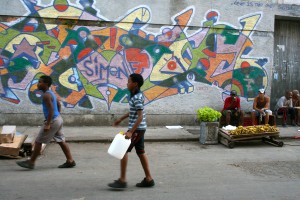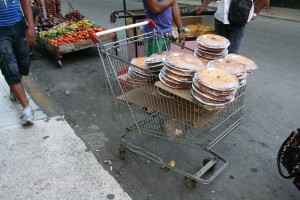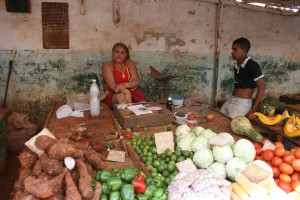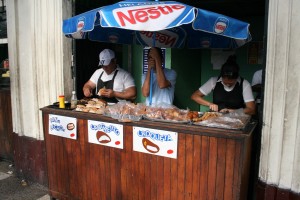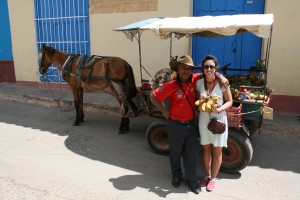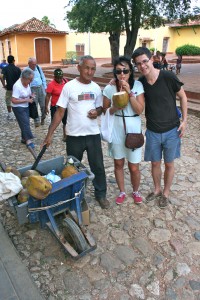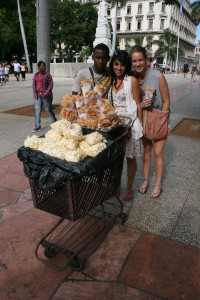Finding Food in Cuba’s Streets
April 4, 2012 by admin
One of the highlights of roaming Havana’s maze of busy downtown streets was the opportunity to stumble upon and sample the wide variety of food being sold on the street. The awesome array ranged from ready to go snacks and small meals sold at window ‘cafeterias,’ produce carts and farmers markets, shopping carts filled with sugared wonton chips and popcorn, and the most classic Cuban food on the go- personal pizzas. With all these easily accessible treats, a walk down any block in Old Havana was a mouthwatering experience.
Shockingly, the abundance of street food I experienced is a relatively new phenomenon in Cuba. In fact, websites dated as recently as 2009 noted the scarcity of street food vendors and instead advertised government run restaurants as well as strictly controlled ‘casa particulares’ and ‘paladars’ as the main places for tourists to find reliable food. Clearly times have changed, and now small entrepreneurs- many in the food sector- have sprung up all over Cuba. This shift happened in 2010 when Raul Castro eased government economic control, granting over 75,000 entrepreneurial licenses to Cubans interested in joining the nations tiny private sector (which emerged during the Special Period in the 1990s). This economic reform increased Cuba’s self-employment rate by 50%, making it one of the Cuban economy’s most radical changes since Fidel Castro nationalized all Cuban business in 1968. By strengthening Cuba’s private sector Raul Castro hoped to resuscitate Cuba’s crippled economy and provide alternatives for the half a million government workers the Cuban labor federation projected would be laid off in the coming years in order to balance the national budget. These dramatic circumstances created the mouthwatering Cuban avenues crammed with food vendors and farmers markets we see today.
When you walk around Havana’s streets there aren’t many material objects tempting your eyes or wallet- but now there is food- spilling out from every other window, living room, and horse cart you pass. In fact, the biggest local crowds were outside the snack shop windows- called ‘cafeterias’. A particularly impressive row of cafeterias lay directly across from the capital building. Each of these shops consisted of a grungy window and counter- sometimes separated from the street by an iron grate- and a small glass case or plastic tray displaying the few items they sold. These little concession windows- complete with a small cardboard sign and crooked script- also peeped out of many residential windows I passed in the local Old Havana neighborhoods. From my wandering the most popular cafeteria items seemed to be thick cut ham sandwiches, cheese or guava empanadas, various fried dough concoctions and of course personal pizzas. It also appeared that each food sold on the street seemed to have its particular vehicle of distribution- pizzas, coffee, sandwiches and fried treats were always sold out of building/home windows. Popcorn and sugar chips were almost exclusively sold out of shopping carts, cane juice was sold out of rural stalls, and fresh produce was sold out of carts or in designated markets.
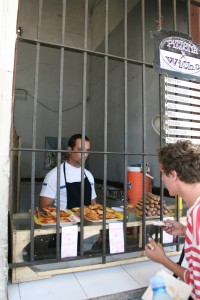
many cafeterias have iron grates between the customer and the food- this makes grabbing your snack a bit tricky
Each city we went to seemed to have its own street food personality. For example I will always remember Cienfuegos as the mecca of personal pizzas. Granted we were walking around at lunchtime, but literally every other cafeteria was selling pizza and every other person was eating it. Known as a ‘peso pizza’ or ‘street pizza,’ Cuban pizza is a favorite with its own distinct character. Thick doughy crust, a thin layer of generously spiced tomato sauce and a sparse sprinkling of rubbery cheese on top- the only acceptable way to eat this pizza is by folding it in half -paper plate and all- and eating the whole thing like a semicircular burrito. What I took away form my bustling lunch time experience in Cienfuegos was that for lunch it seems like- at least here- most Cubans eat fast food (the places that served cooked full meals looked deserted and geared towards tourists). I also learned that mysterious Cuban ice cream flavors often remain a mystery even upon eating- although they are always creamy and delicious.
Sadly in Trinidad we missed out on many of the roadside ‘cafeteria’ food shops because it was a Sunday and most local vendors were closed. Nonetheless Hannah, Spencer and I wandered outside the historic district to sample a pineapple ice cream, questionable hamburger and favorite pizza from the few cafeterias that were open. Determined to survive on street snacks alone, we also bought a bunch of 18 bananas from a nice old man with a horse and cart. Later we quenched our thirst and made a new friend, Oscar Borges Justiz, who pulled a coconut out of his wheelbarrow and cut off the top w his machete, offering the fresh juice inside to Hannah- complete with a straw.
Food sold from street side cafeteria windows, alleyway farmers markets and on mobile carts is clearly a staple in Cuban’s daily lives. From school children walking home with ice cream to older men sitting on their front steps with small coffee cups, Cubans in urban centers enjoying living and eating in public on the street.
References:
http://www.cubaabsolutely.com/articles/feature/article_feature.php?landa=11
http://www.npr.org/2011/09/20/140501399/entrepreneurs-emerge-as-cuba-loosens-control
http://www.nytimes.com/2011/02/04/world/americas/04cuba.html?pagewanted=all
http://www.trazzler.com/trips/old-havana-in-cuba
http://www.cuba-made-easy.com/Eating-drinking-Cuba.html
Leave a Reply
You must be logged in to post a comment.
